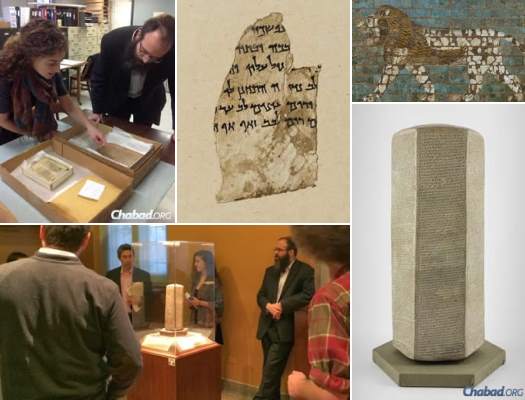
Students Get Eye-Opening Examination of Ancient Artifacts
What do you get when you bring together a rabbi, a museum curator, a Ph.D. candidate and two-dozen college students? A tour of Jewish history that includes ancient clay figurines, fragments of medieval Judeo-Arabic manuscripts and a good dose of Talmudic wisdom.
This all happened Feb. 10 at the Oriental Institute of the University of Chicago, courtesy of Rabbi Yossi Brackman of the Rohr Chabad at the University of Chicago and Hyde Park; Dr. Jack Green, Ph.D., chief curator of the Oriental Institute; and Ph.D. candidate Rachel Schine, whose area of expertise is Near Eastern Language and Culture. Together, they produced a unique experience that brought Judaism’s ancient roots to life using articles from the museum’s public displays and private archives.
One of the artifacts viewed was the 2.5 millennia-old Sennacherib Prism (excavated in what is now northern Iraq), upon which the annals of the Assyrian king Sennacherib are inscribed in Akkadian cuneiform. The prism—one of three in the world—tells of the king’s numerous conquests and building projects, including his war on Jerusalem.
Significantly, his version of the story varies greatly from narrative found in the Hebrew Bible. The books of Kings and Chronicles record thatKing Hezekiah of Judea prayed to G‑d, and an angel slew many of the Assyrian soldiers who had come to lay siege on Jerusalem; thus, Sennacherib retreated. On the prism, Sennacherib’s scribes tell a story in which the Assyrian ruler is victorious and succeeds in making a humbled Hezekiah pay tribute to him, leaving with hundreds of thousands of Jewish prisoners.
Schine says tour helped give a better, healthier perspective of Jewish history. “Seeing the biblical perspective in which Hezekiah is victorious dispels the notion of Jewish victimhood,” she explains. “Appreciating that Judah was perceived as a threat by the Assyrians and not just an easy target was very enlightening.”
Taking the students one generation further back in time, the group examined a giant winged bull (also from northern Iraq) that once stood at the entrance to the throne room in the palace of King Sargon II, Sennacherib’s father, who had exiled people from the 10 tribes dwelling in the Northern Israelite Kingdom in Samaria. The inscription lists the many enslaved people who were brought to build the palace, which presumably included the Israelites, though they are not specifically mentioned.
While the Assyrians were unable to destroy Jerusalem, the First Temple was ultimately razed by Nebuchadnezzar II of Babylon, who brought exiled Jews back with him, including the Prophet Daniel. The students viewed a lion on glazed tile from the processional way leading to the northern gate of Babylonia, which Nebuchadnezzar II had dedicated to the goddess Ishtar.
“You need a way to materialize history,” says Green, “and having people see actual items from those times helps make it real.”
Particularly Fascinating: The Manuscripts
Brackman notes that it was particularly fascinating to show the students Hebrew manuscripts, the oldest of which was a fragment of an extra-biblical work discovered in the Qumran caves near the Dead Sea.
Other manuscripts—some of which were recovered from the Cairo Genizah—included ninth-century writings by the Karaites, a once significant Jewish splinter group that rejected many of the rabbinic traditions and interpretations found in the Talmud.
The presence of Dr. Norman Golb—a leading expert on the Dead Sea Scrolls and the Cairo Genizah, as well as author of Who Wrote the Dead Sea Scrolls? The Search for the Secret of Qumran—added a special dimension to the outing.
Some manuscripts from Baghdad featured Judeo-Arabic, which Schine points out “could be Arabic written in Hebrew characters or Hebrew written in Arabic characters. Neither is so straightforward, though, as the two languages hybridized over time, forming a dialect not unlikeYiddish or Ladino, but composed instead of a mix of Arabic and Hebrew.”
Schine culled the manuscripts from museum archives the public rarely sees. She says she chose items that would serve as natural springboards for discussing Jewish life and scholarship in different eras.
Of particular interest was a fragment of the Bible written in Hebrew with Arabic characters, utilizing the classic Hebrew system of nikud vowelization.
“We capped the group at 24 students,” Brackman explains, “because we wanted to retain the intimate experience and allow everyone to interact with the artifacts and texts. This was amazing for everyone who attended and is something I look forward to doing again.”













Anonymous
There is an exhibit including some kisvei yad of the Rambam right here in NY – shouldn’t our CH students be made aware of it, or even be taken to see it? It’s at Yeshiva University/YIVO museum.
אליהו
מיר דארפן אים ברענגן אהער קיין ברוקלין